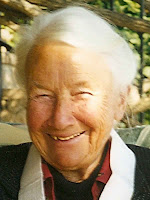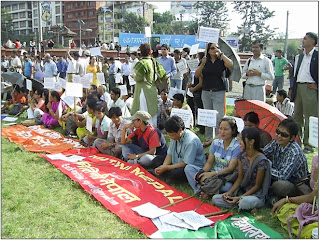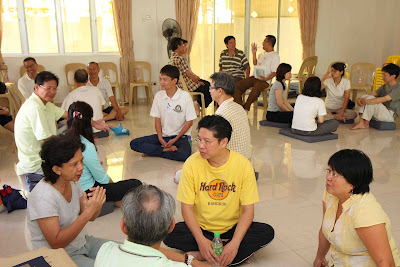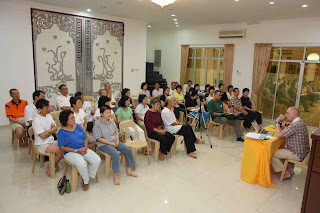Vidyaruci, Sangharakshita's secretary, writes with some of his latest news over the winter months. He says -
“Bhante has been continuing to eschew travel, but has nonetheless been kept busy by his daily meetings with visitors, as well as correspondence, which he has been giving more attention to, despite his finding dictating letters difficult.
“His only trip out of Birmingham in December was to Worcester, to meet sangha members at their new centre, where they had a discussion mainly on the topic of Team Based Right Livelihood. He has enjoyed meeting with two groups of men at Madhyamaloka, one from Croydon, and another all the way from Dublin. Conversation with the latter group centered largely around Bhante's article The Path of Regular and Irregular Steps, which they had come over to study with Dhammaloka and Abhaya. [available as an audio download from FreeBuddhistAudio]
“Bhante has continued to have me read to him. We finished Nagapriya's Visions of the Mahayana, which Bhante enjoyed, describing it as 'a well researched, sympathetic, but not uncritical account of the Mahayana in India and the Far East'. [available from Windhorse Publications] I also read him an article by Bernard Stevens, a mitra from Belgium, which explored the Japanese philosopher Nishida's thought in relation to the Abhidharma. Bhante enjoys hearing reportings- in from Shabda, and we get through as much as we can of each issue.
“The RNIB audio book service that Bhante has recently joined seems to be working out well, and he has particularly appreciated two of its offerings recently. Firstly The Last Days of the Raj by Trevor Royle, which describes the political and economic background of Bhante's early years in India. Of course he knew much of it already, but he also learned things that were new to him. The second audio book was Peter the Great, by Derek Wilson, which Bhante described as giving a 'thorough and interesting, if lurid light on Russia past and present'.
“Bhante's health has been stable, and has not been too badly affected by the transition to winter. On Wednesday 16th December he had another lucentis injection into his eye, which is the last planned for the time being. Other than this his health has been good, despite the wintry weather.

“January was even more quiet than the last. Vidyadevi has visited a few of times, in order to interview Bhante about some of his favourite poetry. Bhante has received visitors most days, though even this tailed off a bit over Christmas and New Year. For a week of this period I was away visiting family, so Dharmamati stepped back into his old role, for which thanks to him. Bhante's own Christmas celebrations extended no further than having a meal with the Madhyamaloka community, followed by a chat round the open log fire. The snowy weather, as well as disrupting the travel plans of some if his visitors, has precluded his daily walks for a number of weeks.
“Bhante has had a number of friends read to him from various books. Paramartha read him Porphory's
The Cave of the Nymphs, a neo-Platonic allegory of the soul's descent into the world of space and time. Devamitra read him extracts from
A God Who Hates, in which Wafa Sultan describes the effect of Islam on her early life in Syria. I have read him the beginning of Francis Brassard's
The Concept of Bodhicitta in Santideva's Bodhicaryavatara, the new introduction to
The Religion of Art, by Dhivan, and we have recently started
The Book of Kadam, a new translation of an important text from Tibetan Buddhism.
"Bhante has also listened to a few interesting audio books. These include
To The Navel of the World by Peter Somerville-Large, the navel in question being the region around Mount Kailash and Lake Manasarova in Western Tibet;
A Nation of Trees by Rosemary Millington, an account of the author's two and a half years in the Australian outback, and
Isambard Kingdom Brunel by Adrian Vaughan, a biography of the famous nineteenth century engineer”.
Vidyaruci
Madhyamaloka, Birmingham, UK
FWBO News can also add that in October Sangharakshita wrote to all Order Members asking them to cease using the terms ‘untouchable’ and ‘ex-untouchable’. His letter is copied below as it is of course applicable to all members of the Sangha.
22/10/09
Dear Dharmacharis and Dharmacharinis,
I have recently received a letter signed by 11 Indian Order members and mitras, all of whom are at present living in Cambridge. They have asked me to request Western Order members not to use the expression ‘ex-untouchable’ as they do not feel comfortable with it. They rightly say they are Buddhists, not untouchables, having left the caste system behind them. I very much sympathise with their feelings, and I am therefore happy to second their request and to urge all Western Order members who are still using the terms ‘untouchable’ and ‘ex-untouchable’, whether in speech or writing, to cease doing so forthwith.
Urgyen Sangharakshita
Sangharakshita's website,
www.sangharakshita.org, continues to host many of his books in a free downloadable pdf format, as well as his recent 'Conversations' and a collection of his poetry.
Labels: Sangharakshita


























 rss
rss